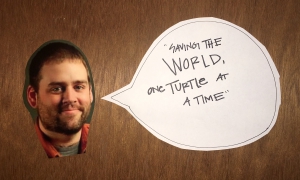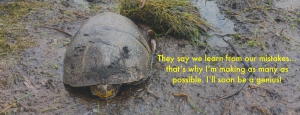
Throughout our summer blog we have mainly focused on our accomplishments and the fun we have had while working. However, this summer was not always sunshine and rainbows. This week we want to highlight some of the “challenges” we experienced and never discussed.
Oh the things we have learned…
Don’t freeze your Complete Blood Count samples
We came up here over two months ago, wide eyed and innocent. We had a less than stellar start however as on our very first day, John accidentally put all of the samples we were supposed to test that day in the freezer instead of the refrigerator. Unbeknownst to him at the time, cells in the blood that we wanted to count, lyse (burst and die) when frozen. So already we were off to a shaky start.
Centrifuge lids prevent explosions
It is one big, simple step when running PCV/TP in the lab – put the lid on! It’s a mistake 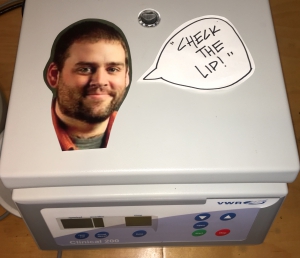 you are bound to make at least once, and apparently Lauren’s time to do it was this summer. The worst part was, the day this happened we had a full centrifuge full of 12 samples. 5000 rpm (check), 5 minute time (check), all tubes pushed to the outer edge (check), centrifuge closed (check), “start.” Within seconds glass shatter was heard. With a sigh, Lauren clicked “stop” and opened it to find with no surprise a blow-up of blood spatter. All the tubes had to be re-made and re-run; the second time though with the lid.
you are bound to make at least once, and apparently Lauren’s time to do it was this summer. The worst part was, the day this happened we had a full centrifuge full of 12 samples. 5000 rpm (check), 5 minute time (check), all tubes pushed to the outer edge (check), centrifuge closed (check), “start.” Within seconds glass shatter was heard. With a sigh, Lauren clicked “stop” and opened it to find with no surprise a blow-up of blood spatter. All the tubes had to be re-made and re-run; the second time though with the lid.
Kestrels + Water = 100% humidity
A kestrel is a device we use daily in the field as a wind and weather tracker. Usually it is 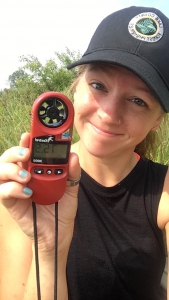 the first thing you take out of your pack, turn on and swing over a branch while working up a turtle to collect temp and humidity. In the middle of the marsh sometimes you have no option but to loop it over a flimsy tree or tall cattail. Lauren’s choice of tall cattails of course were not always the best and one day her cattail decided to bend, snap and drop her kestrel directly in to the water. Unfortunately, she didn’t realize this until she completed her turtle work-up and went to grab for it to record weather data. After pulling out the sunken data she read right there on the side “not water proof.” It was hot and humid this day but when the kestrel read 100% humidity she had to assume it was because it was dripping with water and weeds.
the first thing you take out of your pack, turn on and swing over a branch while working up a turtle to collect temp and humidity. In the middle of the marsh sometimes you have no option but to loop it over a flimsy tree or tall cattail. Lauren’s choice of tall cattails of course were not always the best and one day her cattail decided to bend, snap and drop her kestrel directly in to the water. Unfortunately, she didn’t realize this until she completed her turtle work-up and went to grab for it to record weather data. After pulling out the sunken data she read right there on the side “not water proof.” It was hot and humid this day but when the kestrel read 100% humidity she had to assume it was because it was dripping with water and weeds.
Pink and purple stains don’t mix well
To dye each blood smear, we use three different stains in a certain order so that the cells are highlighted. When using the stain, liquid from 3 bottles are poured into 3 separate containers to dip the slides into and afterwards the liquids are returned to the bottles. Unfortunately, John discovered that it’s important to put the liquids back into the SAME bottles when he accidentally poured the pink dye into the purple dye bottle, rendering it useless.
GPS units can’t track themselves
Because we needed to be able to pinpoint where we were getting these turtles from, Dr. Allender entrusted us each with a high tech GPS unit that even has navigation and 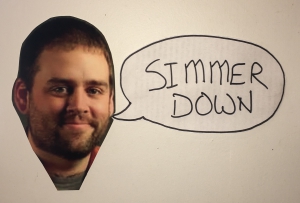 camera functions. So of course John lost his within the first 5 weeks. During the excitement of Blanding’s Bowl, John was stumbling and tripping over vegetation at a quicker pace in an effort to secure more handcaps and after finding none in a pond he was searching, realized he was one GPS unit lighter than he had been 5 minutes ago. The GPS must have bounced out of his waders pocket into the brush or water. So after 30 minutes of retracing steps, and multiple attempts to find it later in the week, John’s GPS was officially declared lost to the wilds of Lake County.
camera functions. So of course John lost his within the first 5 weeks. During the excitement of Blanding’s Bowl, John was stumbling and tripping over vegetation at a quicker pace in an effort to secure more handcaps and after finding none in a pond he was searching, realized he was one GPS unit lighter than he had been 5 minutes ago. The GPS must have bounced out of his waders pocket into the brush or water. So after 30 minutes of retracing steps, and multiple attempts to find it later in the week, John’s GPS was officially declared lost to the wilds of Lake County.
Marsh water doesn’t taste great
When we find turtles we want to work up, we put them in our pockets or backpacks to carry them to dry land. While hustling to collect traps on a day full of thunderstorms, Lauren had two 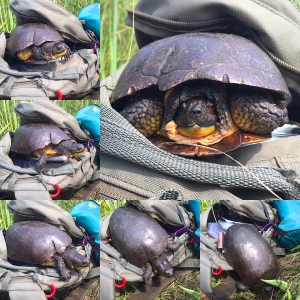 turtles collected in her backpack, both itching to get out. While carrying two handfuls of collected traps and trudging through thigh-high water she accidentally dropped a trap. Turning around to grab it, she found what had made the splash was actually a turtle from her backpack! The turtle scratching at her pack somehow managed to get the zipper wide enough to pop out! A face first dive, a mouth full of water and lost sunglasses were necessary to get this turtle back and that’s exactly what happened – drama scene right out of a movie. Lauren went swimming and learned marsh water does not taste the best, and waders are heavier flooded.
turtles collected in her backpack, both itching to get out. While carrying two handfuls of collected traps and trudging through thigh-high water she accidentally dropped a trap. Turning around to grab it, she found what had made the splash was actually a turtle from her backpack! The turtle scratching at her pack somehow managed to get the zipper wide enough to pop out! A face first dive, a mouth full of water and lost sunglasses were necessary to get this turtle back and that’s exactly what happened – drama scene right out of a movie. Lauren went swimming and learned marsh water does not taste the best, and waders are heavier flooded.
And the learning doesn’t stop there…
- Cover slip(s) crack when you zoom in too far on the microscope
- Leaving car windows down when it storms leads to a musky and wet ride home
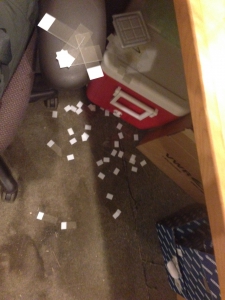
- When a scale reads “ErrE” that is not the turtles weight
- Dropping a brand new box of microscope slides on the floor just plain sucks
- Computers without internet must be synced often or a lot of data will be lost
- Raccoons steal things, including traps
- Swamp water, leaky waders and hangnails may lead to “swamp foot” aka bacterial infections
- Blanding’s turtles are escape artists and can crawl out of pockets, backpacks, bins with lids, etc.
- Heavy rain can flood marshes and sink traps
- Bean can lids can cut fingers
- Plan for more rather than less; we had to restock supplies four times this summer
- Male turtles “enjoy” being notched and swabbed
- The depth of the marshes are not always as they appear
- Flooding your waders means you bring everyone donuts the next day
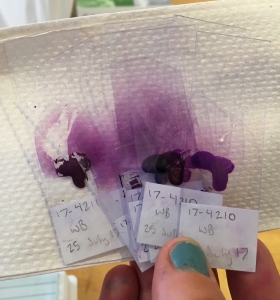
- Blanding’s turtle diarrhea does not smell great, especially when it squirts out and lands on your boot
- Turtles pee on you no matter where you point their cloaca
- Blood smears and bottoms of sinks do not result in readable slides
- Carrying 10 traps at a time is hard and sometimes they just slip away from under your arm while walking
- Legs DO NOT get tan when wearing waders
- Putting Dr. Allender’s face around our lab with quotes kept us motivated and laughing (especially during late nights of hemocytometers) all summer long
In conclusion:
2 coverslips = $
1 GPS unit = $$
1 hema stain set = $$$
A summer spent researching Blanding’s turtles? PRICELESS
We have definitely had some pitfalls and mishaps but for every problem we encountered, there was always an incredible moment of finding a new Blanding’s turtle, getting a really good sample, finally making that hemocytometer work to make up for it, or forever engraving in your mind to not do that again. They say that you learn from your mistakes. We just hope that Dr. Allender hasn’t learned to never put the two of us on a project together again…. (:
